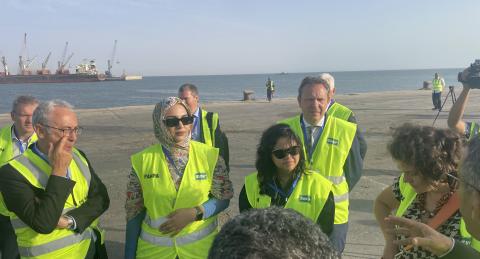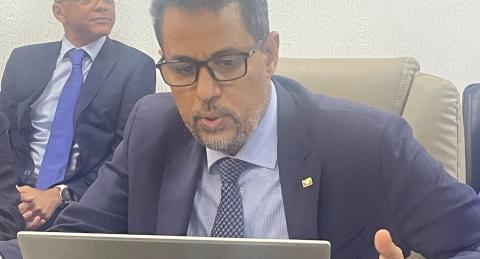As Mauritania’s green hydrogen law nears adoption attention must turn to project development and finance
Mauritania is making good progress on realising its vision of 85 GW of renewable energy in the coming decades. The World Bank estimates the country’s green hydrogen production potential at 12 million tonnes annually. Mauritania’s Hydrogen Law has been drafted by the Ministry of Petroleum, Energy and Mines and is being reviewed by the government's lawyers, aiming for parliamentary adoption just before or after elections scheduled for later this spring.
In a meeting on Thursday 25 April with President Mohamed Ould Ghazouani, Energy Minister Nani Chrougha was noticeably satisfied that the law had reached this stage and that the country was ready for the next phase: making use of some of the world's best wind and solar opportunities.
The meeting took place during a visit to Mauritania organised by the EU Delegation in Nouakchott and Hydrogen Europe which included a delegation of 35 companies, financial institutions and others supporting the government in realising its renewable energy vision. Developers like Chariot/Total and CWP (GH2 member) were in town and we also visited Nouadhibou, its port and the national iron-ore producer SNIM.

"Mauritania's renewable energy and green hydrogen potential is massive. Now it is all about de-risking. We urgently need to focus on project development, infrastructure needs and which financial instruments can get these projects over the line."
Jonas Moberg (CEO, The Green Hydrogen Organisation)
Through the finalisation of the draft law, the government hopes that it has struck the important balance between offering attractive financial terms necessary to landing large developments, and ensuring that in the longer term these developments bring state revenue and long-term economic opportunities.
Other high priorities for the government include the need to provide sufficient certainty now for projects to move to the next phase, while building in the necessary flexibility allowing for development optimisation later. It was also clear from the excellent presentations of the law by our friend and the government's key official Lehbib Khroumbaly and his team that they wish to ensure that the law provides a timetable and milestones, allowing developers who have secured land rights the time they need to do thorough studies and preparations. At the same time, the government wishes of course that companies do not hold rights to land without making progress towards real industrial projects.
Many judgment calls needs to be made. These are particularly challenging when we are now developing a new industry with many unknowns, and when there is competition from governments with deep pockets. EU Ambassador Gwylim Jones concluded that the indications received from different parties suggested that a sound compromise had been reached.
It is time to move to the next phase. In parallel to the government adopting the law, the work now needs to focus on reaching general agreements ("Convention Globale") between key developers and the government.
Key Terms - Draft Hydrogen Law (Hydrogen Code)
- Exemption from VAT and export tax for Green Hydrogen projects;
- Reduction of import customs duties from 4% to 2% for the first wave of projects;
- Corporate income tax staged starting at 15%, and 30% in case of superprofits;
- Projects are divided into two periods: one for development and a second for construction and development (projects can be phased freely).

Chariot/TotalEnergies and CWP are among those to have secured land. Others showing interest in the country include BP, Fortescue (GH2 member), Zhero, Conjuncta and GreenGo. With the law likely to be in place soon, it should become clear in the coming months which of these companies are prioritising general agreements with the government. An important aspect in the next phase will be the first investment decisions that projects take on the pathway to Final Investment Decision (FID). There is little value in discussing final projects with tens of gigawatts, unless there is a realistic means to secure funding and execute initial industrial phases often likely at a significantly smaller scale.
CWP Global: Project AMAN
During the visit, CWP reported on progress with their African flagship 30 GW AMAN green hydrogen hub project. CWP reported “outstanding” results from their first two years of wind and solar measurement. The Environmental and Social Impact Assessment is also under way with public consultations taking place this week, and the front end engineering design is scheduled for 2025.
The government has many friends supporting its efforts to create a strong enabling environment. The World Bank recently approved a new USD 100 million stage of its comprehensive support. It has funded the legal advice the government has received from the law firm Meyer Brown and also supported the government in providing a study on infrastructure needs. This long-awaited study, due to be published in July-August, will be analysed closely as clarity is needed on which infrastructure projects, roads, ports, pipelines and transmission infrastructure the government will prioritise and how these will be financed.

Many of us including commercial developers, consultants and development partners can support the government by working together, sharing information and ensuring options and alternatives are whittled down quickly. At the risk of trivialising large complex realities, it is important to keep these questions at the top of our mind as the country's extraordinary wind and solar resources are developed:
How can the country benefit from its vast iron ore deposits and SNIM's infrastructure and what does a realistic vision of using renewable energy to produce steel in-country look like? How would sufficient reliable power be secured, can it be done without gas and would gas in fact hinder the development of a genuinely green steel product? I recalled during the visit how German Chancellor Olaf Scholz said in the presence of President Ould Ghazouani during last year’s Paris climate finance summit that we “must recognise and support the first round of refinement of resources in the country of origin.”
Where will green ammonia be produced? Here key questions include the extent to which joint infrastructure will be required and how quickly such infrastructure can be put in place? It was excellent that colleagues from the ports of Antwerp and Rotterdam participated in the visit. Already now, more collaboration and support can be provided to ensure managerial excellence in the ports of Nouakchott and Nouadhibou, preparing to welcome large renewable energy and steel projects. This is one dimension of what green corridors mean in practice.
Will green hydrogen be exported? If so, how? There is probably a need for pipelines in the region, though how they will be drawn and financed is far from clear. Until European hydrogen buyers take a stronger interest in contributing to the development of secure supply chains from outside of Europe, it is challenging to make progress. During the visit, Thierry Leperq, a green hydrogen visionary and longstanding friend of Mauritania, made a strong case for collaboration. It is certainly possible for competitors to collaborate in developing markets. There are good reasons why the EU has robust rules for how such collaboration can take place and plenty examples of joint platforms and markets used to overcome barriers for individual actors.
Chariot and TotalEnergies: Project Nour
It was reported in March that Chariot and TotalEnergies have completed and submitted their feasibility study for project Nour, and that they are now working on the investment framework, engineering and offtake. The planned electrolysis capacity is 10 GW, with an initial phase of 3 GW renewable energy capacity and 1.6 GW electrolysis, capable of producing 150 thousand tonnes of green hydrogen annually.
There is an understandable impatience to make concrete progress. Mauritania has a young population, huge development needs and expectations are high. Managing these expectations will be important in the years to come. One way of doing this is to make relatively rapid progress on some infrastructure projects likely to be required in any case for the country's development.
The elephant in the room remains finding customers, and with them finding finance to structurally de-risk projects and take projects to financial investment decision. The presence of the European Investment Bank at the visit was excellent, and there is no shortage of development finance institutions wanting to support the renewable energy economy in countries such as Mauritania.
The kinds of large-scale energy and infrastructure projects that are being developed in Mauritania demonstrate exactly why the ongoing reforms of the Multilateral Development Banks are needed: to support projects in lower income countries by providing scaled-up and sufficient de-risking and the long-term security that investments require. This is widely recognised across the development finance community.
Building on the Nouakchott Message on climate finance, there is an urgent need to be specific about what this kind of project financing actually means. While many projects may not yet be ready for the development banks, the development banks themselves, the Multilateral Investment Guarantee Agency (MIGA) and bilateral guarantee agencies can work together more closely to demonstrate what will be required. When the developers come knocking closer to investment decisions, the size of the engagement and de-risking needs will be unprecedented.
Mauritania has some of the world’s best and largest natural resources. Harnessing the opportunities is desperately needed for the development and climate aims of the country, as well as decarbonisation in Europe and beyond. We should all urgently support the government in its efforts to enable this economic opportunity. I hope that we at GH2 can contribute even more in the months and years ahead.
GH2 - one of many partners
As part of its aim to accelerate the growth of a responsible green hydrogen sector, GH2 is supporting the government and industry in Mauritania through several initiatives:
With the Green Hydrogen Standard, a set of requirements ensure responsible land and water management, and a framework for how to deliver the Sustainable Development Goals and contribute to long-term job creation. The Standard is also designed to assist developers and their customers to track tracking green hydrogen from production to use, ensuring alignment with key international rules and standards, such as the EU’s renewable fuels of non-biological origin (RFNBO) requirements.
Through Good Green Hydrogen Legislation and Contracting, we have developed a set of guidance to allow decision makers to draw on emerging global practices and standards when developing legal frameworks governing the green hydrogen industry. In the coming month, we will publish guidance on model clauses for legislation and regulations, key considerations for offtake agreements and how to maximise local benefits across the green hydrogen value chain.
Through the Green Hydrogen Legal Capacity Unit, we hope to continue to provide legal support to the government, alongside that of the World Bank and the German government's CONNEX programme.
By providing the Secretariat for the Africa Green Hydrogen Alliance, the coalition of governments, GH2 have worked closely with Lehbib Khroumbaly and the focal points in the nine other AGHA member countries to accelerate green hydrogen development on the continent. One effort this year has been the work on fiscal terms and fiscal modelling of green hydrogen projects, supported by the Africa Climate Foundation. Guidance and an open source financial model will be published in the coming month.
Under the African Green Products Initiative (AGPI), led by the Global Renewables Alliance (GRA) and backed by funding from the African Climate Foundation, GH2 is working with the Mauritanian government in its efforts to find buyers of green steel.